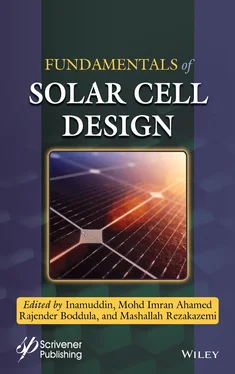15 Chapter 15Figure 15.1 Various device arrangements of PSC (a) n-i-p mesoscopic, (b) n-i-p p...Figure 15.2 Planckian locus in the CIE 1931 chromaticity diagram.Figure 15.3 (a) CIE RGB color matching functions, (b) CIE XYZ standard observer ...Figure 15.4 Structure of ST-PSC producing multiple-colors by the exploitation of...Figure 15.5 ST-PSC with TiO 2/SiO2 multilayer dielectric mirror integrated at the...Figure 15.6 Schematic reflection modulation of the cell producing multiple-color...Figure 15.7 Semitransparent neutral-colored dewetted planar heterojunction PSC [...Figure 15.8 The step-by-step schematic illustration of the spin coating techniqu...Figure 15.9 Illustration of energy levels of commonly used ETL, HTL, and transpa...Figure 15.10 Schematic illustration of the device architecture having (MUTAB-bas...Figure 15.11 Schematic structure of ST-SC cell and organic materials used.Figure 15.12 Devices in operation. The transparent window mode (left) allows ful...Figure 15.13 Illustration of the proposed ST-PSC stack [53].Figure 15.14 Illustration of (a) monolithic two-terminal (2T) and (b) mechanical...Figure 15.15 General schematic and energy potential diagrams of the perovskite a...
16 Chapter 16Figure 16.1 Hierarchy of generations of solar cells.Figure 16.2 (a) Schematic diagram of a flexible solar cell. (b) Image representi...Figure 16.3 Images representing examples of flexible PV panel: (a) manufacturing...Figure 16.4 Schematic diagram for R2R processing.Figure 16.5 Schematic diagram for CBD process.Figure 16.6 Typical experimental setup of CVD.Figure 16.7 Schematic diagram of the dip-coating process.Figure 16.8 Schematic showing the different stages of spin coating technique.Figure 16.9 Schematic resembling the screen printing technique.Figure 16.10 (a) Scheme of collection mode SNOM setup in transmission geometry. ...Figure 16.11 Generic spectroscopic ellipsometry (SE) configurations.Figure 16.12 Experimental setup of TRPL.Figure 16.13 Schematic diagram of ESR spectrometer experimental setup.Figure 16.14 The SEM measurement setup.Figure 16.15 I-V characteristic of solar cell.Figure 16.16 I-V characteristics measurement setup.Figure 16.17 EQE measurement setup.Figure 16.18 (a) Spectrally resolved. (b) Spatially resolved EL setup.
1 Chapter 2 Table 2.1 Various solar cell technologies and its efficiency. Table 2.2 Energy band gap of various absorber and metal nanoparticles. Table 2.3 Effect of various plasmonic nanostructures on solar cell technologies.
2 Chapter 6Table 6.1. Various materials used as essential parts of DSSCs with their photovo...
3 Chapter 7Table 7.1. A list of different Ru-based dye sensitizers with their photoelectroc...Table 7.2. Calculated efficacy of cells with various counter electrodes [109].
4 Chapter 8Table 8.1. The irradiation values.Table 8.2. Sun irradiation attributes.Table 8.3. Top 10 confirmed module and cells.
5 Chapter 10Table 10.1. Properties and features idealized for solar cell materials.Table 10.2. Notable performance results for c-SI SCs and modules.Table 10.3. Notable performance results for Si TFSCs.Table 10.4. Notable performance results for III-V semiconductor-based SCs.Table 10.5. Notable performance results for CIGS SCs.Table 10.6. Notable performance results for CdTe SCs.Table 10.7. Notable performance results for fullerene and non-fullerene OSCs.Table 10.8. Notable performance results for DSSCs.Table 10.9. Notable performance results of PSCs.
6 Chapter 12Table 12.1. Molecular weights and thermal data of copolymers P1 and P2 [89].
7 Chapter 14Table 14.1. Evolution and PCE of different C/Si heterojunctions [67].Table 14.2. Evolution and PCE of different C/Si heterojunctions [67].Table 14.3. Advances in X-anions/A-cations substitutions [133].Table 14.4. PV characteristic of the Sn-based perovskites [210].Table 14.5. Working spectropolarimetries [166].Table 14.6. Water network elements [182].
8 Chapter 15Table 15.1. Comparison of different photovoltaic materials and their optoelectro...Table 15.2 Summary of representative semitransparent perovskite solar cells with...Table 15.3. Summary of different single-junction and tandem semitransparent pero...
9 Chapter 16Table 16.1. Comparison chart of RSCs and FSCs.
1 v
2 ii
3 iii
4 iv
5 xv
6 xvi
7 xvii
8 xviii
9 1
10 2
11 3
12 4
13 5
14 6
15 7
16 8
17 9
18 10
19 11
20 12
21 13
22 14
23 15
24 16
25 17
26 18
27 19
28 20
29 21
30 22
31 23
32 24
33 25
34 26
35 27
36 28
37 29
38 30
39 31
40 32
41 33
42 34
43 35
44 36
45 37
46 38
47 39
48 40
49 41
50 42
51 43
52 44
53 45
54 46
55 47
56 48
57 49
58 50
59 51
60 52
61 53
62 55
63 56
64 57
65 58
66 59
67 60
68 61
69 62
70 63
71 64
72 65
73 66
74 67
75 68
76 69
77 70
78 71
79 72
80 73
81 74
82 75
83 76
84 77
85 78
86 79
87 80
88 81
89 83
90 84
91 85
92 86
93 87
94 88
95 89
96 90
97 91
98 92
99 93
100 94
101 95
102 96
103 97
104 98
105 99
106 100
107 101
108 102
109 103
110 104
111 105
112 106
113 107
114 108
115 109
116 110
117 111
118 112
119 113
120 114
121 115
122 117
123 118
124 119
125 120
126 121
127 122
128 123
129 124
130 125
131 126
132 127
133 128
134 129
135 130
136 131
137 132
138 133
139 134
140 135
141 136
142 137
143 138
144 139
145 140
146 141
147 142
148 143
149 144
150 145
151 146
152 147
153 148
154 149
155 150
156 151
157 152
158 153
159 154
160 155
161 156
162 157
163 158
164 159
165 160
166 161
167 162
168 163
169 164
170 165
171 166
172 167
173 169
174 170
175 171
176 172
177 173
178 174
179 175
180 176
181 177
182 178
183 179
184 180
185 181
186 182
187 183
188 184
189 185
190 186
191 187
192 188
193 189
194 190
195 191
196 192
197 193
198 194
199 195
200 196
201 197
202 198
203 199
204 200
205 201
206 202
207 203
208 204
209 205
210 206
211 207
212 208
213 209
214 210
215 211
216 212
217 213
218 214
219 215
220 217
221 218
222 219
223 220
224 221
225 222
226 223
227 224
228 225
229 226
230 227
231 228
232 229
233 230
234 231
235 232
236 233
237 234
238 235
239 236
240 237
241 238
242 239
243 240
244 241
245 242
246 243
247 244
248 245
249 247
250 248
251 249
252 250
253 251
254 252
255 253
256 254
257 255
258 256
259 257
260 258
261 259
262 260
263 261
264 262
265 263
266 264
267 265
268 266
269 267
270 268
271 269
272 270
273 271
274 272
Читать дальше












